
Barnard's Express
Encyclopedia
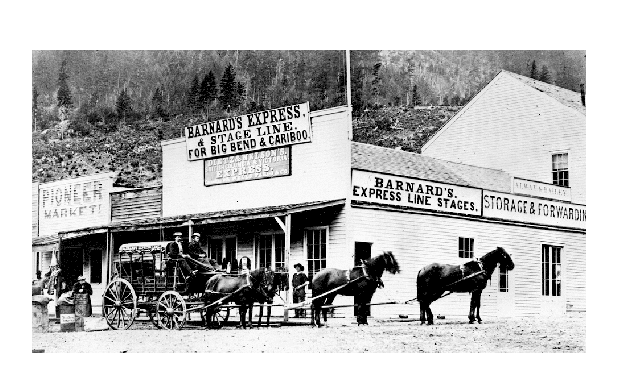
Cariboo
The Cariboo is an intermontane region of British Columbia along a plateau stretching from the Fraser Canyon to the Cariboo Mountains. The name is a reference to the woodland caribou that were once abundant in the region...
and Fraser Fort George
Fraser-Fort George Regional District, British Columbia
The Regional District of Fraser-Fort George is a regional district located in the Central Interior of British Columbia. It is bounded by the Alberta border to the east, the Columbia-Shuswap and Thompson-Nicola Regional Districts to the south/southeast, Cariboo Regional District to the southwest,...
regions in British Columbia
British Columbia
British Columbia is the westernmost of Canada's provinces and is known for its natural beauty, as reflected in its Latin motto, Splendor sine occasu . Its name was chosen by Queen Victoria in 1858...
, Canada
Canada
Canada is a North American country consisting of ten provinces and three territories. Located in the northern part of the continent, it extends from the Atlantic Ocean in the east to the Pacific Ocean in the west, and northward into the Arctic Ocean...
from 1861 until 1921.
The company's beginnings date back to the peak of the Cariboo Gold Rush
Cariboo Gold Rush
The Cariboo Gold Rush was a gold rush in the Canadian province of British Columbia. Although the first gold discovery was made in 1859 at Horsefly Creek, followed by more strikes at Keithley Creek and Antler Horns lake in 1860, the actual rush did not begin until 1861, when these discoveries were...
when hordes of adventurers were descending on the Cariboo region. There was a great demand for transportation of passengers to and from the goldfields, as well as the delivery of mining equipment, food supplies and mail between Victoria
Victoria, British Columbia
Victoria is the capital city of British Columbia, Canada and is located on the southern tip of Vancouver Island off Canada's Pacific coast. The city has a population of about 78,000 within the metropolitan area of Greater Victoria, which has a population of 360,063, the 15th most populous Canadian...
and Barkerville.
The stage years
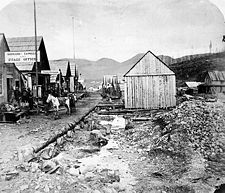
Cariboo Road
The Cariboo Road was a project initiated in 1860 by the colonial Governor of British Columbia, James Douglas...
was operated by William Ballou in 1858. Others soon followed, usually one or two man operations where the proprietor himself packed the express goods, either on his back or with the help of a trusty mule.
In December, 1861, Francis Jones Barnard
Francis Jones Barnard
Francis Jones Barnard , often known as Frank Barnard Sr., was a prominent British Columbia businessman and Member of Parliament in Canada from 1879 to 1887....
established a pony express
Pony Express
The Pony Express was a fast mail service crossing the Great Plains, the Rocky Mountains, and the High Sierra from St. Joseph, Missouri, to Sacramento, California, from April 3, 1860 to October 1861...
from Yale
Yale, British Columbia
Yale is an unincorporated town in the Canadian province of British Columbia. It was founded in 1848 by the Hudson's Bay Company as Fort Yale by Ovid Allard, the appointed manager of the new post, who named it after his superior, James Murray Yale, then Chief Factor of the Columbia District...
to Barkerville. The company had originally been owned by William Jeffray and W.H. Thain and had been known as the Jeffray and Company's Fraser Express. In the summer of 1862, Barnard merged his company into the British Columbia and Victoria Express Company and won the government contract to deliver the mail.
In 1863 Barnard incorporated a two-horse wagon on the run from Lillooet
Lillooet, British Columbia
Lillooet is a community on the Fraser River in western Canada, about up the British Columbia Railway line from Vancouver. Situated at an intersection of deep gorges in the lee of the Coast Mountains, it has a dry climate- of precipitation is recorded annually at the town's weather station,...
to Fort Alexandria. Another freighting company, Dietz and Nelson operated a stagecoach
Stagecoach
A stagecoach is a type of covered wagon for passengers and goods, strongly sprung and drawn by four horses, usually four-in-hand. Widely used before the introduction of railway transport, it made regular trips between stages or stations, which were places of rest provided for stagecoach travelers...
between Victoria, Lillooet and Yale, connecting with Barnard's Express.
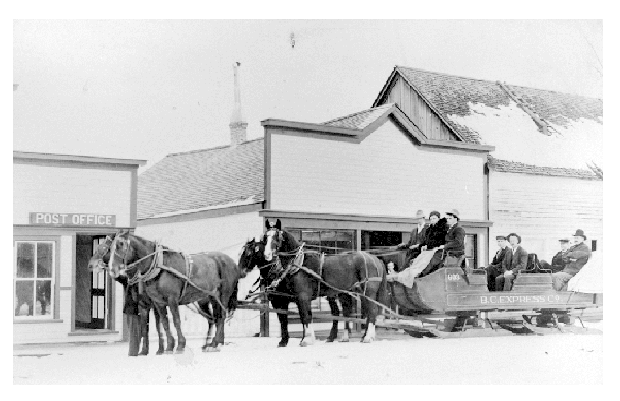
Barnard's Express incorporated as the British Columbia Express Company in 1878, and became commonly known as the BX. By then company consisted of Barnard, holding one half interest, with Stephen Tingley
Stephen Tingley
Stephen Tingley was a stagecoach driver and one of the original owners of the pioneer transportation company BC Express that served the Cariboo region in British Columbia, Canada for 60 years, from 1860, when it was first founded as Barnard's Express, until 1920, when it ceased its sternwheeler...
and James Hamilton each holding one quarter interest.
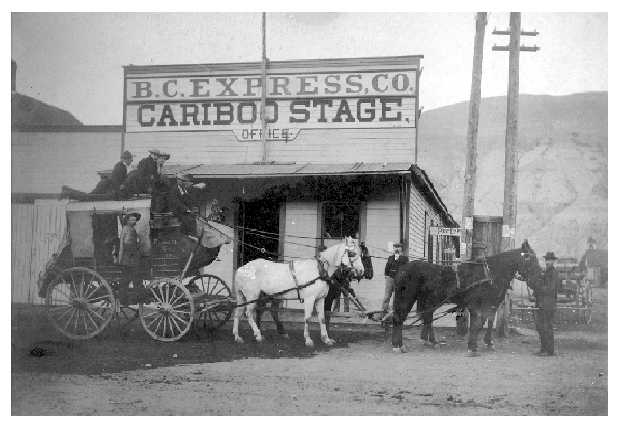
Fraser River
The Fraser River is the longest river within British Columbia, Canada, rising at Fraser Pass near Mount Robson in the Rocky Mountains and flowing for , into the Strait of Georgia at the city of Vancouver. It is the tenth longest river in Canada...
was opened, and trains came to Lytton
Lytton
- People :* Lady Constance Lytton Suffragette and author* David Lytton-Cobbold, 2nd Baron Cobbold* Edward Bulwer-Lytton, 1st Baron Lytton, Diplomat and author...
. It was at this time that Stephen Tingley moved his headquarters and established it at Spences Bridge.
In 1886 Hamilton had died and Barnard sold out to Tingley who thus became sole owner. That February, Tingley made his final move to Ashcroft and drove continuously until 1897 when he sold the company to a group of Toronto lawyers headed by Charles Vance Millar
Charles Vance Millar
Charles Vance Millar was a Canadian lawyer and financier. However, he is now best known for his penchant for practical jokes and his unusual will which reflected that sense of humor.-Early years:...
. In 1903, Willis West became General Manager, a position he held until the company demise in 1921.
The stages

In 1876, the company had a stagecoach built in California specifically for the visit of the Governor General
Governor General of Canada
The Governor General of Canada is the federal viceregal representative of the Canadian monarch, Queen Elizabeth II...
, Lord and Lady Dufferin
Frederick Hamilton-Temple-Blackwood, 1st Marquess of Dufferin and Ava
Frederick Hamilton-Temple-Blackwood, 1st Marquess of Dufferin and Ava, KP, GCB, GCSI, GCMG, GCIE, PC was a British public servant and prominent member of Victorian society...
, who rode in it from Yale to Kamloops and back. The coach was painted in the bright red and yellow BX colours and had the Canadian coat of arms
Coat of arms
A coat of arms is a unique heraldic design on a shield or escutcheon or on a surcoat or tabard used to cover and protect armour and to identify the wearer. Thus the term is often stated as "coat-armour", because it was anciently displayed on the front of a coat of cloth...
on its front panels. It cost $50 a day to ride in this famous coach, but many visiting diplomats and English aristocracy
Aristocracy
Aristocracy , is a form of government in which a few elite citizens rule. The term derives from the Greek aristokratia, meaning "rule of the best". In origin in Ancient Greece, it was conceived of as rule by the best qualified citizens, and contrasted with monarchy...
rode in the Dufferin when they went hunting in the Cariboo.
The horses

Oregon
Oregon is a state in the Pacific Northwest region of the United States. It is located on the Pacific coast, with Washington to the north, California to the south, Nevada on the southeast and Idaho to the east. The Columbia and Snake rivers delineate much of Oregon's northern and eastern...
. Then, in 1868, 400 head were purchased in California and Mexico
Mexico
The United Mexican States , commonly known as Mexico , is a federal constitutional republic in North America. It is bordered on the north by the United States; on the south and west by the Pacific Ocean; on the southeast by Guatemala, Belize, and the Caribbean Sea; and on the east by the Gulf of...
and driven to the company's ranch in Vernon
Vernon, British Columbia
Vernon is a city in the south-central region of British Columbia, Canada. Named after Forbes George Vernon, a former MLA of British Columbia who helped found the famed Coldstream Ranch, the City of Vernon was incorporated on December 30, 1892. The City of Vernon has a population of 35,944 , while...
. Later, when the Canadian Pacific Railway
Canadian Pacific Railway
The Canadian Pacific Railway , formerly also known as CP Rail between 1968 and 1996, is a historic Canadian Class I railway founded in 1881 and now operated by Canadian Pacific Railway Limited, which began operations as legal owner in a corporate restructuring in 2001...
was completed, most of the company's horses were bought locally or were shipped from Alberta
Alberta
Alberta is a province of Canada. It had an estimated population of 3.7 million in 2010 making it the most populous of Canada's three prairie provinces...
or Saskatchewan
Saskatchewan
Saskatchewan is a prairie province in Canada, which has an area of . Saskatchewan is bordered on the west by Alberta, on the north by the Northwest Territories, on the east by Manitoba, and on the south by the U.S. states of Montana and North Dakota....
.
The company had a strict policy that they would not purchase any horses that were broke. The company wanted their horses trained exclusively for staging, a process that generally took three months, even then they were never truly broken and had to be expertly handled. A hostler
Hostler
An hostler or ostler in the horse industry is a groom or stableman, who is employed in a stable to take care of horses...
would lead the teams out to the stages only once the baggage had been secured and the passengers and driver were safely seated. Once harnessed to the stage, the reins were given to the driver and he could release the brake. The stage horses often leaped and reared at the start of a trip, but settled into a smooth trot once they were underway. The whip rarely had to be used to encourage them, as they knew the next station meant a good feed and a warm stable.
The stations were approximately 18 miles apart and the teams were changed at each one. The hostlers at the stations took pride in taking care of the company's horses, often competing to see who kept the teams in the best condition. One rule that was strictly followed was that each horse had its own harness, which was cleaned every time it was taken off. To ensure that the horses always had proper shoes, traveling horseshoers with portable forge
Forge
A forge is a hearth used for forging. The term "forge" can also refer to the workplace of a smith or a blacksmith, although the term smithy is then more commonly used.The basic smithy contains a forge, also known as a hearth, for heating metals...
s visited the stage stations regularly.
The drivers
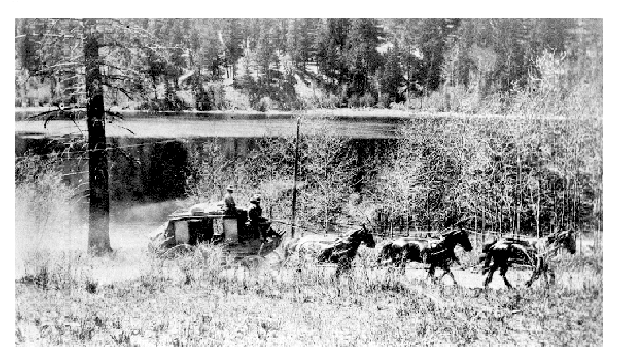
The last stage was driven to Soda Creek
Soda Creek
Soda Creek is a rural subdivision 38 km north of Williams Lakein British Columbia, Canada. Located on the east bank of the Fraser River, Soda Creek was originally the home of the Xat'sull First Nation. Soda Creek Indian Reserve No. 1 is located on the left bank of the Fraser River, one mile...
by Charles G. Major. He was not one of the regular drivers, but the messenger in charge of Barnard's Express between Barkerville and Quesnel
Quesnel, British Columbia
-Demographics:Quesnel had a population of 9,326 people in 2006, which was a decrease of 7.1% from the 2001 census count. The median household income in 2005 for Quesnel was $54,044, which is slightly above the British Columbia provincial average of $52,709....
. Major took the stage out as he was on his way to Cariboo in the spring, and Mr. Stephen Tingley, best known driver and final owner, took charge on the return trip. Other noted drivers were Stephen Tingley's son, Fred Tingley, Al Young, J.B. Leighton, James Hamilton, W.A. Johnston and William Humphreys.
Stage routes and fares
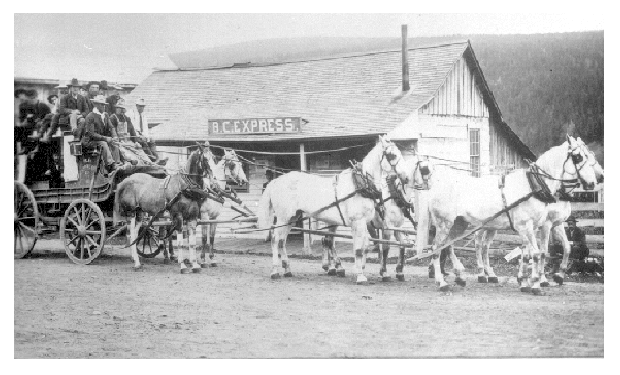
Clinton, British Columbia
Clinton is a village in British Columbia, Canada, located approximately 40 km northwest of Cache Creek and 30 km south of 70 Mile House.It is considered by some to straddle the southern edge of the Cariboo country of British Columbia, although others consider Ashcroft-Cache Creek, Lillooet, Savona,...
(50 miles).
The best time ever made was by special conveyance from Yale to Barkerville. The 380 miles from Yale to Barkerville was covered in 30 hours of continuous driving. The usual stage time for the same distance was four days.
After the company's headquarters moved to Ashcoft in 1886, the main stageline extended from Ascroft to Barkerville, a distance of 280 miles. Other branch lines led to mining camps and settlements all over the Cariboo.
The stage fare from Ashcroft to Barkerville was $37.50 in the summer and $42.50 in the winter. Passengers who left the train
Canadian Pacific Railway
The Canadian Pacific Railway , formerly also known as CP Rail between 1968 and 1996, is a historic Canadian Class I railway founded in 1881 and now operated by Canadian Pacific Railway Limited, which began operations as legal owner in a corporate restructuring in 2001...
at Ashcroft and boarded a stage at 4am could expect to arrive at 83 Mile House that evening and Barkerville two days later.
The sternwheeler years
In 1903 it was announced that the Grand Trunk Pacific RailwayGrand Trunk Pacific Railway
The Grand Trunk Pacific Railway was a historical Canadian railway.A wholly owned subsidiary of the Grand Trunk Railway , the GTPR was constructed by GTR using loans provided by the Government of Canada. The company was formed in 1903 with a mandate to build west from Winnipeg, Manitoba to the...
would be coming through from Winnipeg
Winnipeg
Winnipeg is the capital and largest city of Manitoba, Canada, and is the primary municipality of the Winnipeg Capital Region, with more than half of Manitoba's population. It is located near the longitudinal centre of North America, at the confluence of the Red and Assiniboine Rivers .The name...
to Prince Rupert
Prince Rupert, British Columbia
Prince Rupert is a port city in the province of British Columbia, Canada. It is the land, air, and water transportation hub of British Columbia's North Coast, and home to some 12,815 people .-History:...
via the Yellowhead Pass
Yellowhead Pass
The Yellowhead Pass is a mountain pass across the Continental Divide of the Canadian Rockies. It is located on the border between the Canadian provinces of Alberta and British Columbia, and lies within Jasper National Park and Mount Robson Provincial Park....
. In anticipation of the influx of new settlers to the region, Charles Millar expanded the company's services into sternwheelers and automobiles and extended the route to Fort George
Prince George, British Columbia
Prince George, with a population of 71,030 , is the largest city in northern British Columbia, Canada, and is known as "BC's Northern Capital"...
.
The company built an office and steamer landing at the new town of South Fort George
South Fort George
South Fort George is a suburb of Prince George, British Columbia, Canada.Before the arrival of the Grand Trunk Pacific Railway in 1914, the Prince George area was known as Fort George and was a Lheidli T'enneh village and Hudson's Bay Company store....
in 1910.
The sternwheelers
The Royal Mail Steamers BXBX (sternwheeler)
The BX sternwheeler was the first of two river steamers built for service on the upper Fraser River by the BC Express Company during the busy era of Grand Trunk Pacific Railway construction....
and BC Express
BC Express (sternwheeler)
The BC Express was a stern wheel paddle steamer that operated on the Fraser River in British Columbia, Canada, from 1912 to 1919. The BC Express was built for the BC Express Company by Alexander Watson Jr to work on the upper Fraser River between Tête Jaune Cache and Fort George during the busy...
were launched in 1910 and 1912 respectively. Both were built by Alexander Watson Jr. at Soda Creek. The BX was built for the route from Soda Creek to Fort George, whereas the BC Express was built for the route from Fort George to Tête Jaune Cache.
The captains
The captain of the BX was Owen Forrester BrowneOwen Forrester Browne
Owen Forrester Browne was a paddle steamer captain in British Columbia, and Alberta, Canada.He was born in New Westminster and worked on the lower Fraser and Yukon River sternwheelers before coming to the upper Fraser River in the early 1900s.-Career:...
, an experienced Fraser River pilot. By the time he took command of the BX in 1910, he was already well known in the area, as he had been the captain of the local sternwheeler Charlotte
Charlotte (sternwheeler)
The Charlotte sternwheeler was built in 1896 by Alexander Watson for the Northern British Columbia Navigation Company. The partners of the NBCNC were Stephen Tingley, Senator James Reid and John Irving...
.
The captain of the BC Express was Joseph Bucey, an experienced Skeena River
Skeena River
The Skeena River is the second longest river entirely within British Columbia, Canada . The Skeena is an important transportation artery, particularly for the Tsimshian and the Gitxsan - whose names mean "inside the Skeena River" and "people of the Skeena River" respectively, and also during the...
pilot. On the Skeena, he had piloted the Inlander from Port Essington
Port Essington, British Columbia
Port Essington was a cannery town on the south bank of the Skeena River estuary in northwestern British Columbia, Canada, between Prince Rupert and Terrace, and at the confluence of the Skeena and Ecstall Rivers. It was founded in 1871 by Robert Cunningham and Thomas Hankin and was for a time...
to Hazelton
Hazelton, British Columbia
Hazelton is a small town located at the junction of the Bulkley and Skeena Rivers in northern British Columbia, Canada. It was founded in 1866 and has a population of 293...
.
Sternwheeler routes and fares
The BX made semi-weekly trips from Soda Creek to Fort George, taking two days for the trip upriver and less than a day for the trip back. In 1910, stage fare from Ashcroft to Soda Creek was $27.50 and the steamer fare from there to Fort George was $17.50. Meals were 75 cents and a berth was $1.50. The stage freight charge was sixty dollars a ton and the steamer freight charge was forty dollars a ton.Automobiles
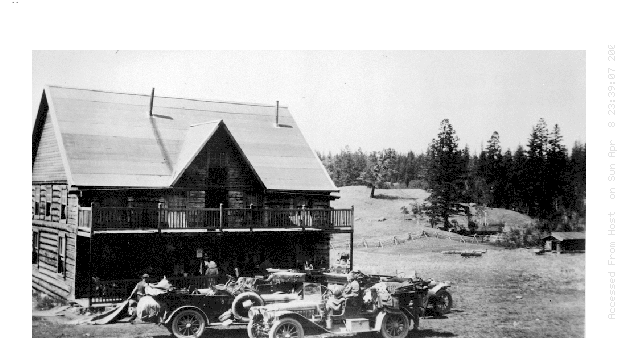
Soda Creek
Soda Creek is a rural subdivision 38 km north of Williams Lakein British Columbia, Canada. Located on the east bank of the Fraser River, Soda Creek was originally the home of the Xat'sull First Nation. Soda Creek Indian Reserve No. 1 is located on the left bank of the Fraser River, one mile...
where they met with the company sternwheelers.
These first cars were Winton Sixes
Winton Motor Carriage Company
The Winton Motor Carriage Company was a pioneer United States automobile manufacturer based in Cleveland, Ohio. Winton was one of the first American companies to sell a motor car.-1896:...
purchased from a car manufacturer in Seattle. The BC Express Company purchased two cars at a cost of $1,500 each and then added a variety of options such as tops at $150, Klaxon horns, $50 and kerosene
Kerosene
Kerosene, sometimes spelled kerosine in scientific and industrial usage, also known as paraffin or paraffin oil in the United Kingdom, Hong Kong, Ireland and South Africa, is a combustible hydrocarbon liquid. The name is derived from Greek keros...
parking lamps, $75. The Winton Company also provided two drivers, who were also mechanics, as there were few people who knew how to operate and fix a vehicle.
Then the company built a garage and machine shop at Ashcroft and, as there were no service stations, arrangements were also made with Imperial Oil
Imperial Oil
Imperial Oil Limited is Canada's largest petroleum company. The company is engaged in the exploration, production and sale of crude oil and natural gas. It is controlled by US based ExxonMobil, which owns 69.6% of its stock...
of Vancouver to supply and deliver in drums the gas and oil that the cars would need. The drums were then placed in key locations along the road.
The company purchased more vehicles throughout the next few years and all were painted red and yellow, the company's colours.
Although the freighting business remained brisk and the cars were a favourite with travelers, they never turned a very large profit for the company. Although private operators could discontinue their services when the road conditions were poor, the BC Express Company had advertised automobile services in all weather conditions from May to October. Fulfilling that promise meant that a large crew of mechanics and drivers had to be kept on staff. In 1913, it cost the company $67,233 to maintain their fleet of 8 Wintons. The largest sum went for repairs, but $15,835.53 was spent on tires alone. Furthermore the total profits that were made that season was only $3,337.23, which the company believed was not a large figure considering the risk and investment involved.
The Grand Trunk Pacific Railway
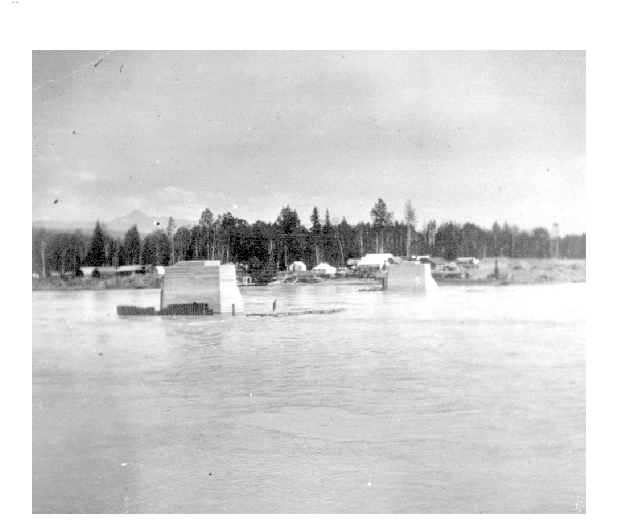
World War I
World War I , which was predominantly called the World War or the Great War from its occurrence until 1939, and the First World War or World War I thereafter, was a major war centred in Europe that began on 28 July 1914 and lasted until 11 November 1918...
had begun and the company's attorney was engaged in war work and was unable to appear. His replacement, a junior partner with little experience, was unable to prepare and present the evidence properly and the company lost the case.
Some historians have suggested that the railway built the bridges to impede navigation out of spite and dislike for the BC Express Company because its owner at that time, Charles Vance Millar, had successfully negotiated with the First Nations
First Nations
First Nations is a term that collectively refers to various Aboriginal peoples in Canada who are neither Inuit nor Métis. There are currently over 630 recognised First Nations governments or bands spread across Canada, roughly half of which are in the provinces of Ontario and British Columbia. The...
people at Fort George to buy the land that the GTP wanted for their town-site, forcing the GTP to sell some of that prime property to Millar, which he developed and was later called the Millar Addition
Millar Addition
The Millar Addition is a suburb of Prince George, British Columbia, Canada. It is named in honor of its developer, Charles Vance Millar, who later became famous for leaving behind the most notorious will in Canadian history, which was the catalyst for the Stork Derby.-History:When the construction...
.
The wreck of the BX
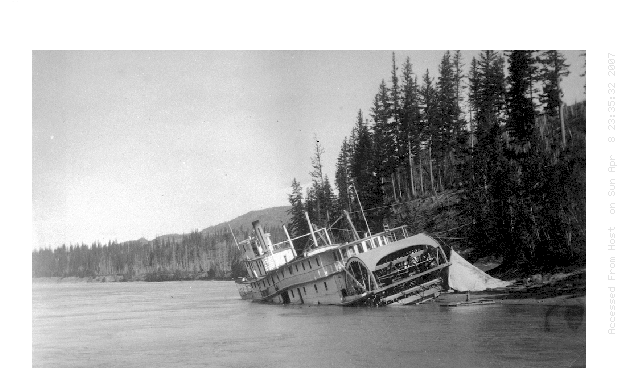
With the construction of the Pacific Great Eastern Railway underway, the sternwheelers were needed to help deliver equipment and food supplies to the work camps. However, with the onset of World War I
World War I
World War I , which was predominantly called the World War or the Great War from its occurrence until 1939, and the First World War or World War I thereafter, was a major war centred in Europe that began on 28 July 1914 and lasted until 11 November 1918...
, John Stewart
John Stewart (financier)
John Stewart was a Canadian financier and railway builder.He was born in Nedd, Assynt, Sutherland, Scotland on 4 Dec 1860; died 24 Sep 1938 Vancouver, British Columbia, Canada....
of Foley, Welch and Stewart
Foley, Welch and Stewart
Foley, Welch and Stewart was an early 20th century American-Canadian railroad contracting company.They built miles of track for the Great Northern Railway, Northern Pacific Railroad, Canadian Pacific Railway, Canadian Northern Railway, Grand Trunk Pacific Railway and Pacific Great Eastern Railway...
called a halt to the PGE's construction. In 1915, the BX worked alone, with the BC Express reserved for special trips. Despite having a monopoly on river traffic, the BX finished the season with a $7000 loss.
In 1916 and 1917, sternwheelers were not used on the upper Fraser River at all. Then, in 1918, after an appeal from the Quesnel
Quesnel, British Columbia
-Demographics:Quesnel had a population of 9,326 people in 2006, which was a decrease of 7.1% from the 2001 census count. The median household income in 2005 for Quesnel was $54,044, which is slightly above the British Columbia provincial average of $52,709....
Board of Trade, the provincial government granted the BC Express Company a $10,000 per year subsidy
Subsidy
A subsidy is an assistance paid to a business or economic sector. Most subsidies are made by the government to producers or distributors in an industry to prevent the decline of that industry or an increase in the prices of its products or simply to encourage it to hire more labor A subsidy (also...
to continue river navigation from Soda Creek to Fort George. The request was justified because Quesnel and the other communities along the river had been promised a railroad, but the construction on the PGE had slowed to a crawl and would in fact not to be completed to Prince George until 1952. In the meantime, the settlers and farmers needed a way to ship their produce to market and steamer fares were the most reasonable option.
The BX ran until August 30, 1919, when she was punctured by an infamous rock called the "Woodpecker" and sank with a 100 tons of bagged cement intended for construction of the Deep Creek Bridge. In the spring of 1920, the salvage work was completed and at a cost of $40,000 the BX was raised and patched sufficiently to get her back to Fort George. The BC Express pushed her back upstream through the Fort George Canyon and to the shipyard at Fort George. This would be the first time in the history of sternwheelers that one would push another upriver through a canyon.
The BC Express ran until November 1920 and then it joined the BX on the riverbank at Fort George, where their hulls were abandoned.
Thus ended the days of the pioneer transportation company that Francis Barnard had established nearly 60 years earlier.
See also
- Steamboats of the Upper Fraser River in British ColumbiaSteamboats of the Upper Fraser River in British ColumbiaTwelve paddlewheel steamboats plied the upper Fraser River in British Columbia from 1863 until 1921. They were used for a variety of purposes: working on railroad construction, delivering mail, promoting real estate in infant townsites and bringing settlers in to a new frontier. They served the...
- Cariboo Gold RushCariboo Gold RushThe Cariboo Gold Rush was a gold rush in the Canadian province of British Columbia. Although the first gold discovery was made in 1859 at Horsefly Creek, followed by more strikes at Keithley Creek and Antler Horns lake in 1860, the actual rush did not begin until 1861, when these discoveries were...
- Fraser Canyon Gold RushFraser Canyon Gold RushThe Fraser Canyon Gold Rush, began in 1858 after gold was discovered on the Thompson River in British Columbia at its confluence with the Nicoamen River. This was a few miles upstream from the Thompson's confluence with the Fraser River at present-day Lytton...
- CaribooCaribooThe Cariboo is an intermontane region of British Columbia along a plateau stretching from the Fraser Canyon to the Cariboo Mountains. The name is a reference to the woodland caribou that were once abundant in the region...

